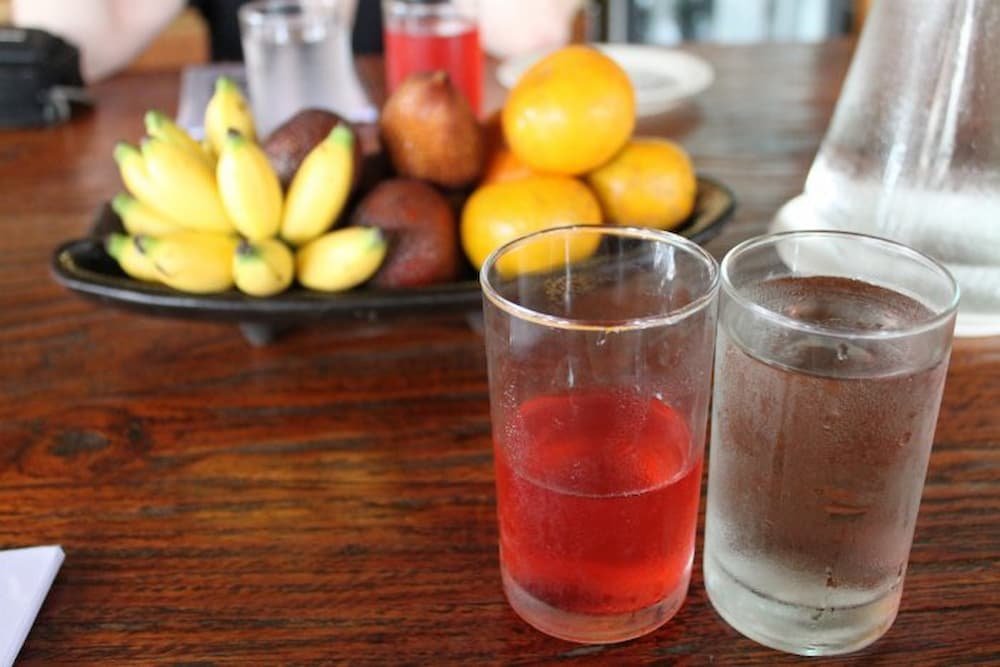How adventurous are you when it comes to eating local cuisine when you travel? To me, being immersed in a culture through food is one of the highlights of my travels. I’ve tried salty, oily, milky tea in Mongolia, pigs’ ears sauteed in garlic in the Philippines, and squirming live octopus tentacles in South Korea – and that’s just in Asia.
Balinese food, particularly in tourist-crammed areas like Kuta, Legian, and Seminyak is not as wacky as the above examples. Compared to countries like Malaysia, Singapore, and Thailand, the cuisine is not overly spicy, however, you can request the hot sambal, a fresh chili concoction as a condiment to compliment any meal. Meals (including breakfast) usually are served with rice and are eaten with a fork in the left hand and a spoon on the right. The spoon serves a dual purpose to cut up any foods (food is usually quite soft and steak is not typical to Balinese cuisine) and scoop up the rice/meat to eat.
A few typical meals in Bali include:
Fried rice, sometimes with chicken and/or seafood, served with a fried egg on top and prawn crackers on the side.

As with Nasi Goreng but with noodles instead of rice.

Indonesian salad of spinach, mung beans, hard-boiled egg, cucumber, and tomato, with sweet peanut sauce as the dressing and prawn crackers on the side. Can be eaten with rice.
Chinese-influenced stir-fried vegetables.

Satay meat (usually fish or chicken) grilled on skewers, served with a sweet peanut sauce.

Being an island, Bali is rich in seafood and while it is pricey, first-time tourists should visit Jimbaran Bay for a dinner on the beach. Here, a multitude of restaurants competes for clientele, offering a selection of fresh seafood (which you can choose), which is marinated in garlic and chili and grilled.
Michael and I were stuffed with a buffet selection at the Seafood Café which included corn soup, a side of vegetables, steamed rice then plates of grilled lobster, fish, prawns, clams, and squid. Traditional Balinese dancing topped off the experience. All this cost about 125,000 rupiahs in total.

For a cheaper (and arguably just as scrumptious) experience, check out Gong Corner on Poppies Lane. Prices (and taxes/surcharge) vary with each restaurant, but Gong always gets a queue of hungry people thanks to its delicious food served cheaper than other restaurants in the heart of Kuta. Here, you can choose from a wide variety of Western, Indonesian, and Chinese-influenced food – we paid on average 53,000 rupiahs for two people, including drinks.
Michael and I also did a cooking class in Bali at the Anika Cooking School, which I would highly recommend to any food lover.

Starting off with a trip to the markets, we were acquainted with various herbs used in Balinese cuisine, including four types of garlic, turmeric, chilies, coriander (cilantro), blocks of crushed peanuts mixed with herbs, and sugar (for satay sauce) and other mouth-watering ingredients.

Getting back to the school (which also doubled as a hotel and spa), we were treated to fresh hibiscus tea and a few very sweet desserts, including sticky rice balls, rolled in grated coconut and liquid palm sugar that burst in your mouth once you bit into it.
The only downside of the cooking school was that we were not able to do the cooking process from start to finish – a lot of the ingredients had been chopped already for us, leaving us to do only some momentary mortar and pestle work and stirring. However, this was balanced by the fact that we saw all the dishes being prepared and cooked before our eyes.
There were 10 dishes in total, including tofu fritters, chicken and fish curries, fried rice, and noodles, followed by a pandan-flavored pudding and banana fritters (deep-fried bananas in batter, usually drizzled in honey).

Similar to other Asian countries, drinking water from the faucet is not recommended, however, bottled water can be readily purchased in convenience stores for 2500 rupiah (about US 30 cents). In restaurants, soft drinks, beer (Bintang is the local brew), and fresh fruit juices (usually tropical fruits such as papaya, mango, pineapple, and coconut) are on the menu.

If this cuisine is starting to sound rather tame to you, be sure to try kopi (coffee) Luwak. Not to be confused with Balinese coffee, kopi luwak is heralded as the best coffee in the world; however, the process of roasting the coffee beans is not for the faint-hearted.
A Luwak (it looks like a cross between a possum and a cat) eats coffee beans and then… poops them out. These are then collected and roasted, giving coffee connoisseurs the erm, unique flavor. At US$20 a cup in cafes it is also not for everyone.
I did try one cup though and while the coffee was smooth and did not leave the bitter aftertaste that so many other brews do, my verdict was that it’s not worth the asking price.

Kopi luwak can be readily found throughout the city of Ubud in Bali, which is renowned also for its fantastic massage/spa and cultural stores. Mike and I stopped by a serene spot in Ubud that had beautiful, manicured gardens and a breathtaking view of the hills and trees below, which not only educated us on the kopi luwak process but also sold a number of other teas, hot chocolates, and coffees.
The hands-down favorite for me and Michael was the ginseng coffee. Light brown in color, it looked like milk had been added and had a smooth, slightly sweet, and mild taste. I would have substituted this for my usual café latte back home in a heartbeat.

If you don’t have an inclination to try Indonesian food (or if you want to take a break from the cuisine), the standard Western fare of burgers, French fries, steaks, pasta and sandwiches can easily be found (including McDonalds, which does home deliveries, and KFC). While vegetarians should be able to find food to cater to their needs, vegans (as in many Asian countries) may struggle – be sure to double-check what oil is being used when cooking.

Here’s a Nasi Goreng recipe to wrap things up… enjoy!
…..and don’t forget those chillis….



I believe picture number one is not Fried Rice, coz fried rice doesn't served with satay and kangkung (vegetable). and of course Mie Goreng with noodle, bcoz noodle in Indonesia is Mie. and Gado-gado cannot be eaten with rice, but with rice cake or we call it Lontong. and that is not Cap Cay, cap cay is mixed with carrot, pineapple, cabbage, with red sauce or without it, you picture is green and with long bean i believe, so I assume is "Trancam" not Cap Cay...
thx and greeting from Indonesian....